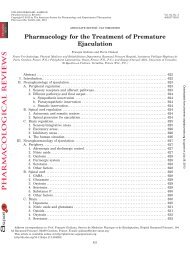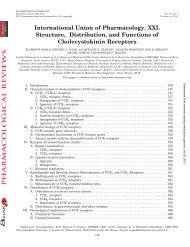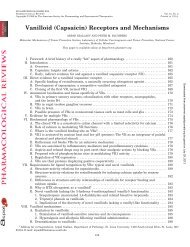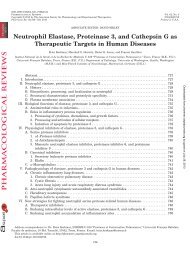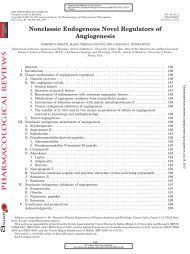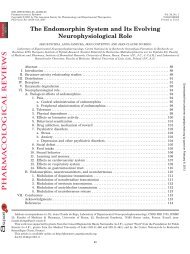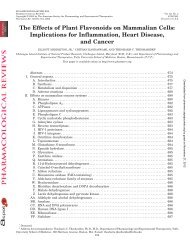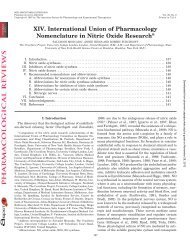Opioids, Reward and Addiction: An Encounter of Biology ...
Opioids, Reward and Addiction: An Encounter of Biology ...
Opioids, Reward and Addiction: An Encounter of Biology ...
You also want an ePaper? Increase the reach of your titles
YUMPU automatically turns print PDFs into web optimized ePapers that Google loves.
<strong>and</strong> naltrexone (2 mg/kg) suppressed responding below<br />
the levels seen after saline injections (Stewart <strong>and</strong> Wise,<br />
1992). Using this reinstatement procedure, the same<br />
research group replicated their findings, in that reexposure<br />
to heroin after abstinence reinstated heroin-seeking<br />
behavior, whereas an injection <strong>of</strong> naloxone did not<br />
(Shaham <strong>and</strong> Stewart, 1996; Shaham et al., 1996, 1997).<br />
Moreover, they found that brief exposure to footshock<br />
stress or corticotropin-releasing hormone reinstated<br />
heroin-seeking behavior, thereby mimicking the effect <strong>of</strong><br />
a noncontingent priming infusion <strong>of</strong> heroin, although<br />
differences may be present with regard to the neurobiology<br />
<strong>of</strong> the various reinstatement stimuli (Shaham <strong>and</strong><br />
Stewart, 1994, 1995; Shaham et al., 1996, 1997). By<br />
contrast, the aversive state <strong>of</strong> opioid withdrawal, induced<br />
by an injection with naltrexone, did not reinstate<br />
drug-seeking behavior. Other abused drugs like amphetamine<br />
<strong>and</strong> cocaine are also capable to reinstate drugseeking<br />
behavior in animals, previously trained to selfadminister<br />
heroin (De Wit <strong>and</strong> Stewart, 1983; De Vries<br />
et al., 1998). It has been argued that the reinstatement<br />
model is relevant for assessing opioid-induced relapse.<br />
In general, it seems that both the pure -opioid agonists<br />
(such as morphine, methadone, codeine, <strong>and</strong> heroin)<br />
<strong>and</strong> the mixed -opioid agonist-antagonists (such as<br />
butorphanol, nalbuphine, <strong>and</strong> buprenorphine) serve as<br />
positive reinforcers in the different i.v. self-administration<br />
paradigms in monkeys <strong>and</strong> rats. On the other h<strong>and</strong>,<br />
-opioid agonists (such as ethylketazocine, ketazocine,<br />
<strong>and</strong> benzomorphan lig<strong>and</strong>s) <strong>and</strong> opioid antagonists<br />
(such as levallorphan, naloxone, <strong>and</strong> naltrexone) do not<br />
maintain self-administration behavior or even maintain<br />
responses that postpone or terminate their injection<br />
(negative reinforcers). In the rat, however, self-administration<br />
<strong>of</strong> (ethyl)ketazocine <strong>and</strong> nalorphine has been<br />
reported.<br />
B. Variables Interfering with Opioid<br />
Self-Administration<br />
Drug-taking behavior in general, <strong>and</strong> opioid selfadministration<br />
in particular, is controlled by a number<br />
<strong>of</strong> variables. The most commonly discussed variables<br />
concern those that can readily be manipulated, e.g., the<br />
dose <strong>of</strong> the drug administered, the route <strong>of</strong> administration,<br />
the schedules <strong>of</strong> reinforcement, <strong>and</strong> the presence or<br />
absence <strong>of</strong> physical dependence, tolerance, <strong>and</strong> sensitization.<br />
In addition, a number <strong>of</strong> predisposing variables<br />
(e.g., preexposure to opioids during gestation, environmental<br />
factors, <strong>and</strong> genetic factors) can affect drugtaking<br />
behavior. The contribution <strong>of</strong> these factors will be<br />
discussed briefly. The discussion will focus on studies<br />
with rhesus monkeys <strong>and</strong> rats since the reinforcing<br />
properties <strong>of</strong> opioids have been studied most extensively<br />
in these species.<br />
1. Dose <strong>of</strong> the Drug. The dose <strong>of</strong> the drug per injection<br />
(“unit dose”) is an important <strong>and</strong> critical factor in drugtaking<br />
behavior. A linear function between the log dose<br />
OPIOIDS, REWARD AND ADDICTION 351<br />
<strong>of</strong> drug delivered per injection <strong>and</strong> the amount <strong>of</strong> drug<br />
taken (Fig. 1) has been shown to exist for various opioids<br />
in different species <strong>of</strong> animals (Weeks <strong>and</strong> Collins, 1964,<br />
1979; Smith et al., 1976; Harrigan <strong>and</strong> Downs, 1978a;<br />
Van Ree et al., 1978; Dai et al., 1989). Moreover, studying<br />
heroin self-administration, it was demonstrated that<br />
the linear relationship between the log unit dose <strong>and</strong><br />
drug intake is present during initial exposure to heroin<br />
<strong>and</strong> in animals physically dependent on heroin (Van Ree<br />
et al., 1978; Dai et al., 1989).<br />
<strong>An</strong> intermediate dose range is optimal for maintaining<br />
self-administration <strong>of</strong> morphine, whereas lower <strong>and</strong><br />
higher doses do not favor it. Data from a wide range <strong>of</strong><br />
unit doses for drug-naive rats taking i.v. morphine on a<br />
continuous schedule <strong>of</strong> reinforcement have been reported<br />
(Smith et al., 1976; Weeks <strong>and</strong> Collins, 1979). On<br />
the fifth or sixth day <strong>of</strong> self-administration, a medium<br />
dose <strong>of</strong> around 30 g/kg morphine per infusion maintained<br />
a maximum number <strong>of</strong> i.v. deliveries. When lower<br />
doses <strong>of</strong> morphine were tested, a progressive decrease in<br />
the rate <strong>of</strong> self-administration was found, probably due<br />
FIG. 1. Self-administration <strong>of</strong> morphine sulfate in rats. Presented are<br />
the mean number <strong>of</strong> self-infusions (A) <strong>and</strong> the mean amount <strong>of</strong> drug<br />
intake (B) by either the i.v. (F) or the intragastric route (E) versus the<br />
unit dose <strong>of</strong> morphine sulfate per infusion. Data from Smith et al. (1976).



